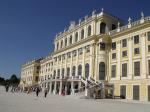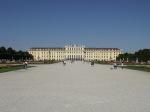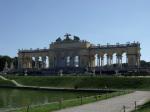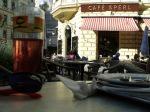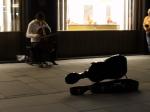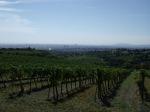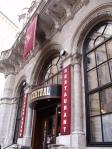Yesterday’s post – the first part of my trip to Vienna – mainly featured the Ringstraße and all the buildings associated with it. Today is much more relaxed, much like the majority of my time in Vienna. If Moscow was all about exploring at speed, then Vienna was a much more sedate affair, the relaxing part of my holiday.
Vienna may be famed for its history, but don’t be fooled into thinking that this means it’s dull and boring once the sun goes down. With beer, beer, more beer and the ‘seems a good idea at the time’ expression “let’s have Jäger shots!” – I was pleasantly surprised that we were up and ready to go by half eleven the following morning, having only staggered back at half four. We decided to walk off our hangovers on a more relaxed day
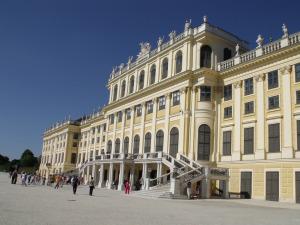
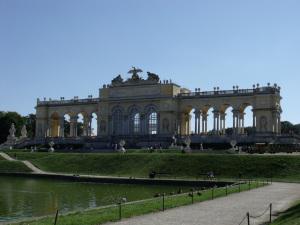
The next day, suitably recovered and somewhat tanned we embarked on our biggest adventure: out to district 19 and up into the hills surrounding the city. Aloft the hills of this district you get the best views of the city and can enjoy a slow wander down through the
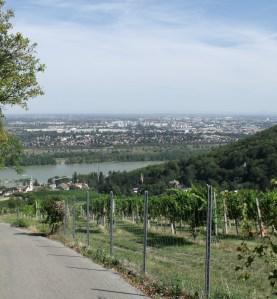

When we’d finished our ‘trek’ down the hill (we took it quite casually) we made our way to the little suburban village of Grinzing (where we were getting the tram back into town from). It was here that I was introduced to one of Vienna’s best secrets – Sturm. Very seasonal, this drink is available only in September and early October; it’s best described as an alcoholic form of grape juice – but it’s not wine. In fact it is fermenting right up until you drink it (leaving a delightful deposit at the bottom of every glass). This incredible beverage is both delectable and deadly in equal measure, and I can tell you from experience that it is quite easy to sit back and have a few glasses without realising the consequences until you stand up.
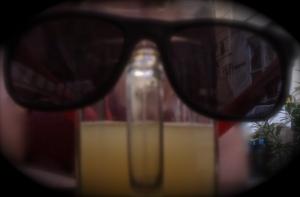
After our late afternoon casual sturm-drinking session we headed back into town for dinner. Continuing the theme of local nourishment I opted for the house speciality, Wiener Schnitzel. This traditional dish (which my inner ten-year-old still finds entertaining) is a Viennese speciality made with pork hammered down a little and made into a sort of escalope, coated in breadcrumbs and fried (or baked); in this case, however, it was made with a cider-like batter. It was utterly delicious, but sadly too large for me to finish (when combined with a few glasses of the pub’s home-brewed beer). In case it’s not already apparent, beer played a fairly large part in my Viennese adventure and I was lucky to have a friend who knew several bars around district 4, all of which brewed their own light and dark beers (or the mix, which combines the two). Is there anything better than kicking back at the end of the day with fantastic beer to make a truly relaxing holiday?
The only thing that comes close is, of course, the other delicacy that Vienna is famous for – CAKE! Lots and lots and lots of cake. All rounded off with some strong coffee, and a bit more cake for good measure. There was not a single day I was in Vienna that we didn’t have stop mid-afternoon for some cake-shaped nourishment. The most famous of which is the scrumptious sachertorte – a dense chocolate cake made up of two sponge layers with apricot jam in the middle (and on the top in one case) which are then covered on the top and sides with a rich dark chocolate icing. It is of no wonder what-so-ever that this one of Vienna’s favourite treats, it is utterly lip-licking-ly delicious. So much so that it was only sitting back after finishing off a slice that I realised I’d forgotten to take a picture of it…
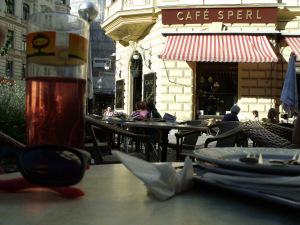
Alongside these cakes there is a big ‘cafe culture’ in Vienna. The famous streets are

And that is Vienna in a sturm glass. If I was quite taken with Moscow, then I completely fell for Vienna. Its mix of history and contemporary culture easily makes it one of the most fun places I’ve ever been and the amount of life that is given over to delicious food and drink makes me want to move there right now. Apart from the large groups of tourists, I don’t think I found anything that annoyed me about this city (quite a feat); the pace of life is both sedate and bustling, you can run for a tram or stand around listening to a cellist busking the evening away in a square, there really does not seem to be a right and wrong. I would visit again even if they had awful food, but since their cake stands can’t eat themselves nor can the beer drink itself I feel I’m obliged to return someday. I think it’s safe to say that Vienna and I have not seen the last of each other, but in the meantime I’ll just have to try creating my very own sachertorte at home.
